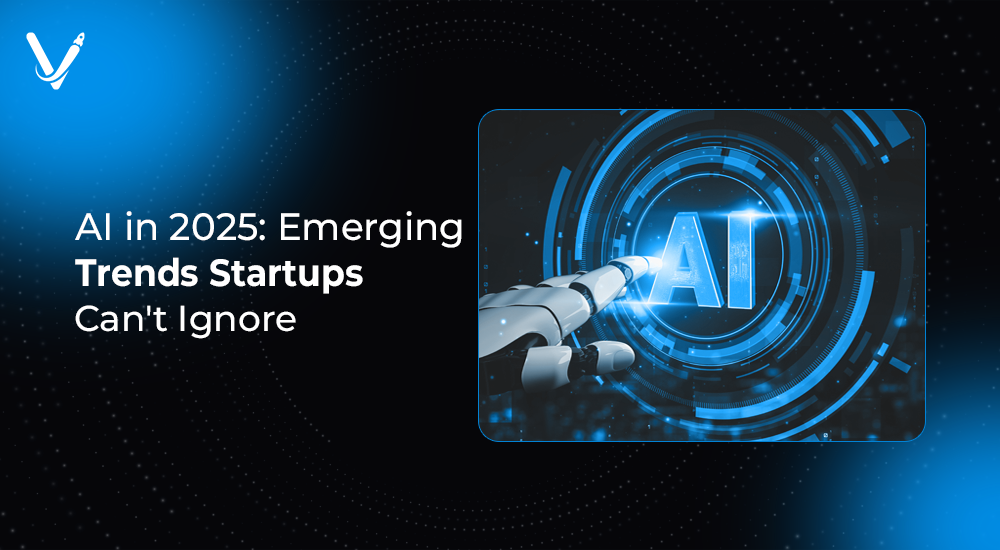AI in 2025: Emerging Trends Startups Can't Ignore


- Jun 17, 2025
Artificial Intelligence is no longer a futuristic buzzword or a competitive advantage only big tech can afford. In 2025, AI has become the engine driving innovation, automation, and intelligent decision-making across industries. For startups, this shift isn’t just an opportunity—it’s a necessity.
As funding becomes more competitive, users more demanding, and markets more dynamic, AI is offering lean teams the power to do more with less. The barrier to entry has never been lower, but the urgency to adopt and innovate has never been higher. This article explores the most impactful AI trends shaping 2025 and reveals why startups that fail to adapt may not survive the next wave.
The release of models like OpenAI’s GPT-4o, Meta’s Llama 3, and Mistral’s Mixtral has dramatically reduced the cost and complexity of AI adoption. No longer do startups need million-dollar infrastructure or in-house PhDs to build smart systems.
What this means for startups:
Case in Point:
Indian startup Sarvam AI built Indic-language generative AI tools using open-source LLMs, empowering millions in rural communities without relying on expensive proprietary tech.
Unlike traditional AI tools that generate outputs based on prompts, AI agents in 2025 can observe, decide, and act independently. Using frameworks like ReAct and AutoGPT, developers are designing systems that can perform multistep tasks—researching, coding, emailing, and even closing sales.
Why this matters:
Example:
Startups using tools like Cognosys or Superagent have implemented AI bots that act as virtual employees—handling customer queries, triaging tickets, and initiating outreach 24/7.
The era of one-size-fits-all marketing is over. AI in 2025 enables dynamic user profiling based on live interaction data, behavior, sentiment, and even tone of voice.
Key benefits:
Real-World Insight:
B2C SaaS startups using predictive personalization have reported a 35% increase in free-to-paid conversion rates using AI-enhanced landing pages and content.
Building your minimum viable product doesn’t need a full-stack engineering team anymore. Platforms like Bubble, Glide, and Adalo now integrate AI capabilities—like image recognition, natural language search, and content generation—straight into drag-and-drop tools.
Why startups should care:
Actionable Tip:
Combine ChatGPT APIs with tools like Make (formerly Integromat) or Zapier to create fully automated workflows between your app, CRM, and marketing platforms without writing backend logic.
In 2025, AI is no longer siloed by data types. Models like GPT-4o, Gemini, and Claude now understand and respond to text, images, audio, and even video—all within a single interface.
Opportunities for startups:
Example:
Healthcare startups are using multimodal AI to assess patient scans, transcripts, and voice logs in tandem—automating diagnoses and documentation simultaneously.
AI bias and misuse have drawn regulatory and public scrutiny. In 2025, startups must bake transparency and compliance into their AI systems.
Best practices:
Insight:
Trust-based AI is a competitive differentiator. Users now choose apps that offer clarity over those that simply offer features.
Predictive analytics is no longer exclusive to enterprise players. Startups are now using AI to predict user behavior, churn, demand surges, and even candidate success during hiring.
Use cases:
Stat Check:
According to McKinsey, startups that use AI for forecasting see 20–25% higher ROI on campaign spend compared to traditional analytics.
As cyber threats evolve, so must defense mechanisms. AI in 2025 is enabling real-time threat detection, anomaly response, and fraud prevention—without requiring a full-time security team.
How startups benefit:
Pro Tip:
Embed AI-driven security tools from day one. Investors increasingly factor in data protection and compliance when evaluating startups.
Today’s most successful startups don’t just use AI—they embed it in a way that enhances core product value. Users don’t “see” the AI, but they feel the result.
For example:
Your move:
Identify where your users are struggling or wasting time. Then inject AI there—not as a feature, but as a friction remover.
Startups are increasingly using hybrid workflows where AI generates options and humans validate them. This keeps the system lean, reduces hallucinations, and builds user trust.
Examples:
Takeaway:
The goal isn’t to replace humans, but to supercharge them.
Genei (UK): Uses AI summarization to condense research papers for analysts and students.
Cala (US): AI-based fashion platform that helps designers auto-generate collections based on market trends.
KissanAI (India): Uses regional language AI to provide real-time farming advice via voice for Indian farmers.
Tability (Australia): Replaced OKRs with AI-driven weekly goal tracking, turning status updates into smart recommendations.
Each of these startups used AI to unlock a new kind of value for their users—without massive capital or large teams.
The AI landscape of 2025 is both a playground and a battleground. Startups that embrace AI thoughtfully are building smarter products, scaling faster, and competing on a global stage with limited resources. Those that ignore it risk obsolescence.
Whether you're an early-stage founder or scaling a Series A startup, the key isn’t to bolt on AI—it’s to embed it as a mindset, a tool, and a team member.
Let Vasundhara Infotech help you integrate next-gen AI solutions tailored to your startup's vision. Our experts specialize in custom AI tools, automation pipelines, and scalable architectures that empower lean teams to do big things.
Copyright © 2025 Vasundhara Infotech. All Rights Reserved.
